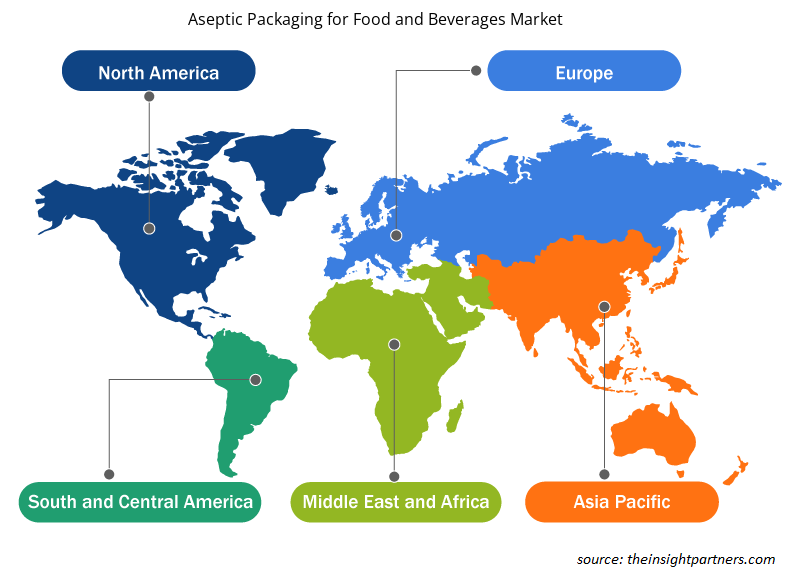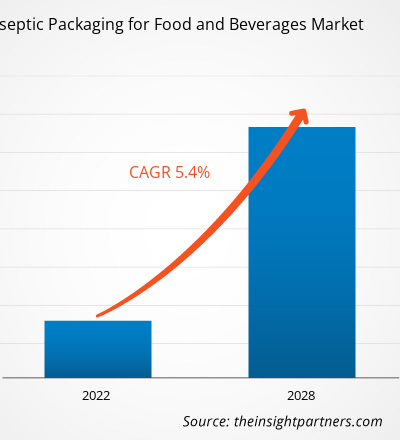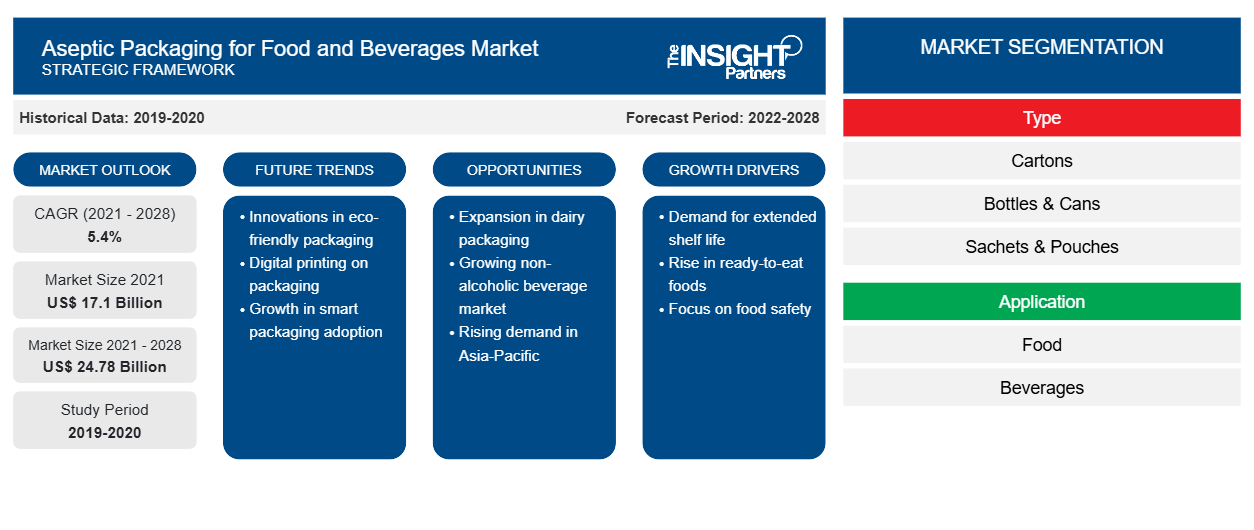食品和饮料无菌包装市场规模预计将从 2021 年的 170.9786 亿美元增至 2028 年的 247.8233 亿美元;预计 2021 年至 2028 年的复合年增长率为 5.4%。
无菌包装是一种高温短时热处理工艺,用于对产品进行商业灭菌,并在灭菌环境下将冷却的灭菌产品装入预灭菌包装中。在此过程中,无菌灌装机用于对包装材料进行灭菌,在灭菌环境下将无菌产品装入容器中,然后密封包装。无菌灌装机不同于传统的食品包装系统,因为在无菌灌装机中,食品和包装是分开灭菌的。无菌包装主要用于食品和饮料行业。全球食品和饮料行业的大规模增长是由于人口增加、生活方式改善、人均收入增加以及对方便食品和饮料的需求激增,预计这将在预测期内为食品和饮料无菌包装市场带来关键机遇。
2020 年,北美占据了全球食品和饮料无菌包装市场的最大份额,而亚太地区预计在预测期内将大幅增长。即食或即饮的概念在北美很流行。最近,由于人们越来越喜欢方便食品和饮料,节省时间和精力,即饮饮料市场大幅增长。食品和饮料的无菌包装对于延长其保质期至关重要。因此,即饮饮料消费的上升趋势正在推动北美食品和饮料无菌包装市场的增长。供应商正在为即饮产品提供专门的无菌包装。例如,Graham Packaging 提供可回收塑料用于无菌包装,以延长单份包装的保质期。因此,该地区提供创新无菌包装解决方案的各种新兴和成熟的市场参与者正在推动市场增长。
定制此报告以满足您的需求
您可以免费定制任何报告,包括本报告的部分内容、国家级分析、Excel 数据包,以及为初创企业和大学提供优惠和折扣
-
获取此报告的关键市场趋势。这个免费样品将包括数据分析,从市场趋势到估计和预测。
COVID-19 疫情对食品饮料无菌包装市场的影响
在 COVID-19 疫情期间,由于原材料供应短缺、工厂停工、劳动力短缺以及疫情安全协议下的其他运营困难,化学品和材料行业面临前所未有的挑战。制造部门停工、原材料采购困难以及物流限制对全球食品和饮料无菌包装市场产生了负面影响。由于 COVID-19 疫情的爆发,消费者对卫生的担忧显著增加。消费者的偏好正迅速转向长保质期和无菌包装,这对食品和饮料市场的无菌包装产生了积极影响。根据 2021 年 Tetra Pak 指数中的一项电子商务研究,消费者越来越多地将无菌纸盒评为在线购物的理想包装材料。因此,由于 COVID-19 疫情的爆发,人们对食品安全和卫生的担忧日益增加,推动了食品和饮料无菌包装市场的增长。因此,COVID-19 疫情对食品和饮料无菌包装市场的影响喜忧参半。Pak Index 2021, consumers increasingly rated aseptic cartons as the ideal packaging material for online purchases. Thus, the increased concern about food safety and hygiene due to the outbreak of COVID-19 is fueling the growth of aseptic packaging for food and beverage market. Thus, the COVID-19 pandemic had a mixed impact on the aseptic packaging for food and beverages market.
市场洞察
无菌包装相关优势正在推动市场增长
食品和饮料产品的无菌包装具有多种益处。无菌包装有助于在不冷藏的情况下将食品和饮料产品的保质期延长约 6 至 12 个月。产品保质期的延长为制造商提供了更多时间在产品过期或失去风味之前发货和销售产品。这也降低了运输和物流成本。与更传统的包装类型相比,无菌包装重量轻且紧凑,使制造商能够通过减轻运输重量来降低运输成本。人们对保质期长的方便食品的需求日益增长,这些食品要么不含细菌污染,要么可以延缓细菌污染。食品防腐剂在食品生产中被广泛使用,以延长保质期并保持产品质量。然而,消费者更喜欢不含合成添加剂的天然产品。无菌包装还可以补充天然成分,使制造商能够生产完全天然的产品,并使其保质期越来越长。因此,无菌包装的各种好处正在推动食品和饮料无菌包装市场的增长。
类型洞察
根据类型,食品和饮料无菌包装市场细分为纸箱、瓶和罐、小袋和包装袋以及其他。在预测期内,小袋和包装袋部分预计将在全球食品和饮料无菌包装市场中以最快的复合年增长率增长。无菌袋包装包括创新的喷口和瓶盖解决方案,可实现安全便捷的包装解决方案。这种包装袋旨在为消费者提供方便和易用性。它的保质期可长达 12 个月,同时提供最佳的营养保留、风味和质地。小袋是小型密封软袋,包括由卷筒或平板薄膜制成的三层或四层包装。对小批量食品和饮料产品的需求不断增长,推动了无菌小袋和包装袋部分的增长。
食品和饮料无菌包装市场区域洞察
Insight Partners 的分析师已详细解释了预测期内影响食品和饮料无菌包装市场的区域趋势和因素。本节还讨论了北美、欧洲、亚太地区、中东和非洲以及南美和中美洲的食品和饮料无菌包装市场细分和地理位置。

- 获取食品和饮料无菌包装市场的区域具体数据
食品和饮料无菌包装市场报告范围
| 报告属性 | 细节 |
|---|---|
| 2021 年市场规模 | 171亿美元 |
| 2028 年市场规模 | 247.8亿美元 |
| 全球复合年增长率(2021 - 2028) | 5.4% |
| 史料 | 2019-2020 |
| 预测期 | 2022-2028 |
| 涵盖的领域 |
按类型
|
| 覆盖地区和国家 |
北美
|
| 市场领导者和主要公司简介 |
|
食品和饮料无菌包装市场参与者密度:了解其对业务动态的影响
食品和饮料无菌包装市场正在快速增长,这得益于终端用户需求的不断增长,这些需求源于消费者偏好的不断变化、技术进步以及对产品优势的认识不断提高等因素。随着需求的增加,企业正在扩大其产品范围,进行创新以满足消费者的需求,并利用新兴趋势,从而进一步推动市场增长。
市场参与者密度是指在特定市场或行业内运营的企业或公司的分布情况。它表明在给定市场空间中,相对于其规模或总市场价值,有多少竞争对手(市场参与者)存在。
在食品和饮料无菌包装市场运营的主要公司有:
- 利乐国际公司
- 密封空气
- 纷美无菌包装公司
- 西得乐集团
- 爱克林公司
免责声明:上面列出的公司没有按照任何特定顺序排列。

- 了解食品和饮料无菌包装市场的主要参与者概况
应用程序洞察
根据应用,食品和饮料无菌包装市场细分为食品和饮料。食品部分进一步细分为乳制品;水果和蔬菜;肉类、家禽和海鲜;加工食品;和其他。饮料部分进一步细分为乳制品、果汁、即饮饮料和其他。2020 年,饮料部门在全球市场中占有更大的份额。无菌包装用于各种饮料,包括水果饮料、乳制品饮料、牛奶饮料、蛋白质奶昔、即饮 (RTD) 茶和冰咖啡、调味水和鸡尾酒。消费者对不含化学品和防腐剂的饮料的需求不断增长,推动了食品和饮料无菌包装市场的增长。
食品和饮料无菌包装市场的主要参与者包括 Tetra Pak International SA、Sealed Air、Greatview Aseptic Packaging Company、Sidel Group、ECOLEAN AB、Krones AG、Syntegon Technology GmbH(博世包装技术)、Amcor Group GmbH、IPI Srl 和 SIG Combibloc Group AG。这些参与者致力于开发创新产品以满足新兴的消费趋势。此外,他们还参与并购、业务扩张和合作,以扩大其全球市场份额。
报告亮点
- 食品和饮料无菌包装市场的渐进式行业趋势可帮助参与者制定有效的长期战略
- 发达市场和发展中市场采用的业务增长战略
- 2019年至2028年食品饮料无菌包装市场定量分析
- 全球食品和饮料无菌包装需求估计
- 波特的五力分析说明了行业中买家和供应商的效力
- 了解竞争市场状况的最新发展
- 市场趋势和前景以及推动和制约食品和饮料无菌包装市场增长的因素
- 通过强调支撑商业利益的市场策略来协助决策过程,从而促进市场增长
- 食品饮料无菌包装市场规模在各个节点的大小
- 市场的详细概述和细分,以及食品和饮料无菌包装行业动态
- 各地区食品饮料无菌包装市场规模及增长潜力
- 历史分析(2 年)、基准年、预测(7 年)及复合年增长率
- PEST和SWOT分析
- 市场规模、价值/数量 - 全球、区域、国家
- 行业和竞争格局
- Excel 数据集
近期报告
相关报告
客户评价
购买理由
- 明智的决策
- 了解市场动态
- 竞争分析
- 客户洞察
- 市场预测
- 风险规避
- 战略规划
- 投资论证
- 识别新兴市场
- 优化营销策略
- 提升运营效率
- 顺应监管趋势























 获取免费样品 - 食品和饮料市场的无菌包装
获取免费样品 - 食品和饮料市场的无菌包装